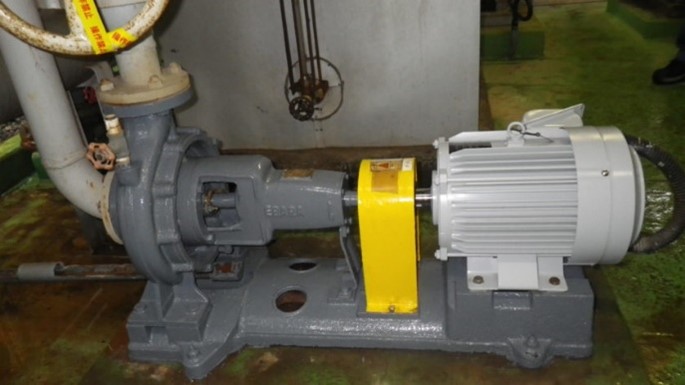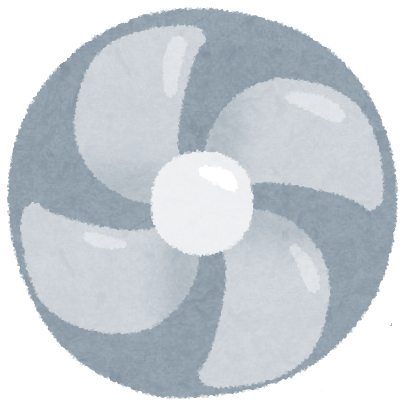What types of pumps are there?
The performance of all pumps is expressed by common indicators of flow rate and head.
It is important to choose a pump that suits your purpose based on the equipment’s flow rate, head, liquid type, etc.
Pumps are broadly classified into non-positive displacement (turbo) pumps, positive displacement pumps, and other types of pumps.
“Non-positive displacement type” mainly utilizes centrifugal force generated by the rotation of an impeller attached to a shaft to give energy to the liquid.
Characteristics of non-positive displacement pumps:
– Flow is relatively continuous due to high-speed rotation
-Suction and discharge lifts are relatively low
-Flow rate fluctuates greatly depending on load
– Quantitativeness is low (*Cascade pumps are an exception and are highly quantitative.)
” Positive displacement type” gives pressure energy to the liquid by the compression effect due to the reduction of spatial volume. There are two types: “reciprocating pumps” that use reciprocating motion, and “rotary pumps” that use rotary motion.
Characteristics of positive displacement pumps:
– Self-priming ability is High and suck up liquid even if there is no liquid inside the pump.
– Discharge capacity is high and ensuring constant discharge pressure and flow rate.
-Compared to non-positive displacement pumps, the amount of liquid pumped is small.
The type of pump to use must be determined based on specifications such as flow rate, pressure, application, and liquid properties.
 Now, let’s explain the types of pumps in a little more detail.
Now, let’s explain the types of pumps in a little more detail.
| 1. Non-positive displacement (turbo) pumps | (1) Centrifugal pumps | A Volute pump |
| B Turbine pump | ||
| C Multi-stage centrifugal pump | ||
| (2) Propeller pumps | A Axial flow pump | |
| B Mixed flow pump | ||
| (3) Viscous pump | Cascade pump | |
| 2. Positive displacement pumps | (1) Reciprocating pumps | A Piston pump |
| B Plunger pump | ||
| C Diaphragm pump | ||
| (2) Rotary pumps (propeller pumps) | A Gear pump | |
| B Screw pump | ||
| C Vane pump |
1. Non-positive displacement (turbo) pumps
They are classified into three types: centrifugal pumps, propeller pumps, and viscous pumps.
1-(1) Centrifugal pumps
A general term for pumps that use centrifugal force.
Typical examples are volute pump, turbine pump, and multi-stage centrifugal pump.
1-(1)-A Volute pump
Liquid flows through a rotating impeller inside the casing, and centrifugal force applies pressure to transport the liquid.
It is used in equipment with a relatively low head of 20m or less.
1-(1)-B Turbine pump
A centrifugal pump with guide vanes attached to the outer periphery of the rotary impeller to more efficiently increase pressure and transport liquid.
It can also be used in equipment with a higher lift (20 to 30 m or more) than a centrifugal pump.
1-(1)-C Multi-stage centrifugal pump
Use this when you want to use it for equipment with a higher lifting height. The mechanism is to stack rotary vanes and casings on a single shaft in stages to increase the lift in stages.
A comparison of the capacities of these three centrifugal pumps is as follows.
Volute pump < Turbine pump < Multi-stage centrifugal pump
Pumps with an impeller resembling a ship’s propeller.
They are divided into two types: axial flow pumps and mixed flow pumps.
1-(2)-A Axial flow pump
The mechanism is that liquid discharged from a concentric impeller flows through a cylindrical surface, and the lifting height is approximately 5 m.
Suitable for use with low lift and large capacity, it is often used for river drainage.
1-(2)-B Mixed flow pump
A structure in which the fluid discharged from the impeller flows within a conical surface whose center is the same as the impeller’s main axis. Used at relatively low head and high flow rate.
1-(3) Viscous pump
Also called cascade pump or vortex turbine pump.
The impeller has a structure with many radial grooves carved into the periphery of the disc. Capable of transferring small amounts of liquid at high pressure. Because it rotates without contact, it is characterized by low wear and high reliability.
2. Positive displacement pumps
2-(1) Reciprocating pumps
A general term for pumps that perform suction and discharge using reciprocating motions such as pistons and plungers.
It is broadly classified into three categories.
2-(1)-A Piston pump
This pump has been used for a long time and sucks in and discharges liquid by reciprocating a piston inside a cylinder and combining two valves.
It is used in kerosene pumps and domestic wells.
2-(1)-B Plunger pump
By reciprocating the plunger (rod-shaped piston)
A pump that changes the volume of liquid inside the pump and pushes it out to the discharge port.
It is often used in high-pressure gas equipment because it is easy to obtain high pressure and the discharge amount can be easily adjusted.
2-(1)-C Diaphragm pump
A pump consists of a membrane called a diaphragm and two check valves.
The volume inside the pump is changed by moving the diaphragm left and right and up and down to perform suction and discharge.
Since it does not have a seal, it has the advantage of not causing burnout due to air trapping or idling, and is used for transporting high viscosity fluids.
2-(2) Rotary pumps (Propeller pumps)
A general term for pumps that perform suction and discharge by rotating gears and rotors.
Since the volume is constant, it is quantitative.
This includes gear pumps, screw pumps, and vane pumps.
2-(2)-A Gear pump -B Screw pump
A pump that transports liquid by meshing gears and screws to guide liquid between the teeth and rotating them is called a gear pump or screw pump.
Although it is suitable for transporting highly viscous liquids, its structure uses gears that mesh together, so it is prone to wear and jamming when transporting fluids containing powder or solids.
2-(2)-C Vane pump (Eccentric pump)
A pump that transports liquid by rotating a rotor with many vanes inside a casing.
It is more resistant to foreign substances than gear pumps and screw pumps, and its efficiency is less likely to decrease even if the vanes are slightly worn.
We will provide the future of customers.(81)467-87-1552
Inquiry Please send E-mail



